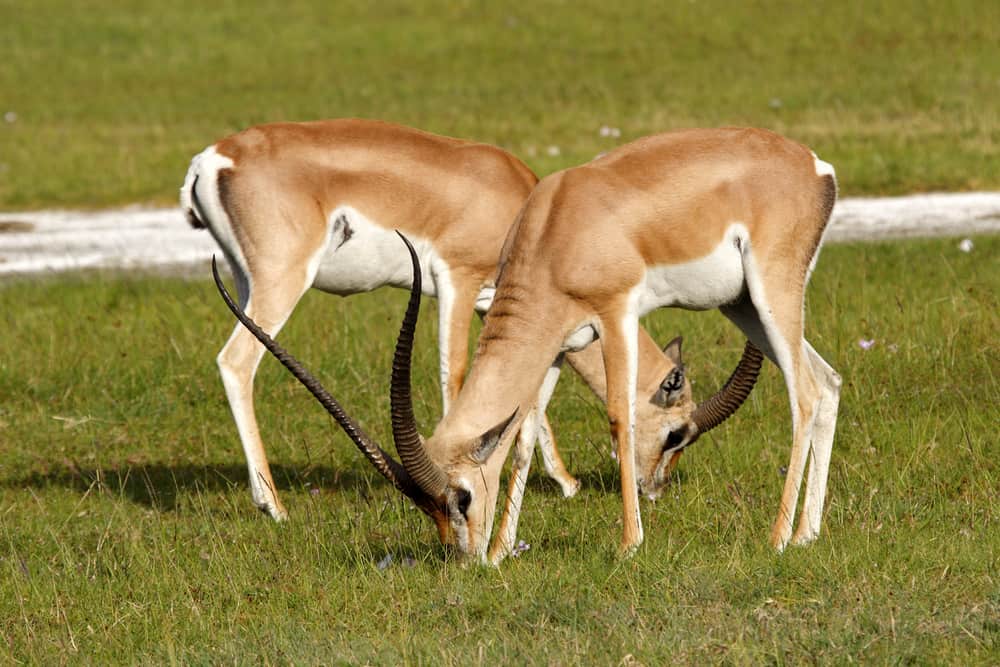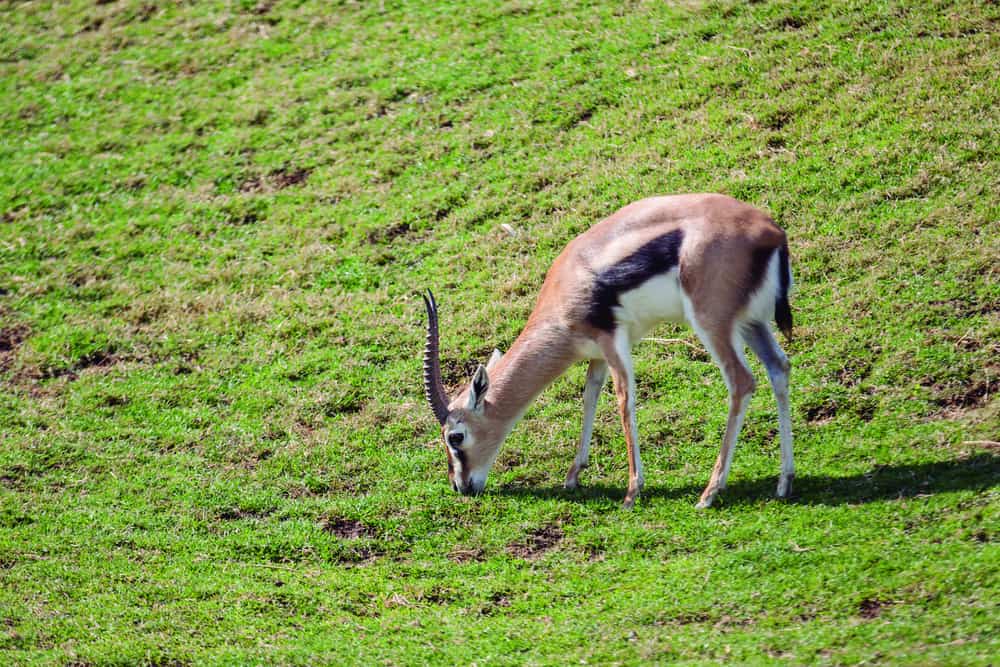Gazelles are herbivores, meaning their diet consists mainly of plants. The majority of species consume grasses, leaves, bushes, and other plants. Because they are so little, many of them stand on their hind legs and reach for the topmost leaves with their long necks.
When there is plenty of water, these animals tend to consume more grass. As it gets drier, gazelles tend to eat more leaves, flowers, buds, and other plant components that contain more water. The precise plant species that each animal consumes differs.
Because they are natural grazers, they will consume everything they come across. They like to go out looking for food early in the morning and late at night to avoid being out in the heat. When they venture out to obtain food, it’s common for them to get more than they need for a single feeding. Gazelles also have an additional stomach to store food, allowing them to go out less frequently.
An intriguing aspect of how gazelles eat is that the liquids they require to survive are typically obtained from the meals they consume. They have extremely big salivary glands, which allow them to produce fluids to compensate for their dry diet. Gazelles require a lot of water while they are young to survive.
However, as they get older and can care for themselves, they learn to rely less on water. Their bodies obtain water from the plant extracts they consume. Some gazelles may go their whole lives without drinking any water.
Gazelle’s food-collecting habits are frequently compared to those of giraffes by researchers who have seen them. Gazelles are similar to giraffes in terms of how harmonically they work to gather food together. Gazelles are known not to bother each other while eating. They calmly gather their leaves and grasses, frequently feeding happily from the same locations or trees.
Facts on Gazelles’ Habitat and Lifestyle
- Gazelles are small and elegant antelopes that can be found throughout Africa and Asia. They look like deer and are related to goats, cattle, and sheep.
- The curving, ringed horns, tan or reddish-brown coats, and white rumps distinguish them as species.
- Their coats are frequently spotted or striped.
- Their light colors work as camouflage and aid in their agility and ability to flee predators.
- Gazelles are significantly smaller than other antelope species. Their height spans between 60 and 110 cm. They are a soft brown color, similar to that of a deer.
- In general, the bottom half of a gazelle’s body is white. Some have a lengthy black mark on the adjacent section of their back and belly.
- The horns of male gazelles are long and curled.
- When confronted by predators, gazelles exhibit a unique aptitude, the movement known as stotting, or pronking: They jump into the air, raising all of their feet off the ground at the same time.
- The majority of gazelles reside in Africa and Asia’s hot, arid savannas and deserts.
- Gazelles reduce their hearts and livers to keep hydrated in these harsh settings. Breathing can cause the animal to lose a significant amount of water. Because a smaller heart and liver use less oxygen, the animal may breathe more deeply and lose less water.
- Gazelles are especially swift animals, with the ability to quickly shift direction at high speeds to dodge the prey without running out of steam.
- Some gazelles can run at speeds of up to 97 kilometers per hour. A gazelle can generally run at a continuous speed of 50 kilometers per hour.
- Gazelles live in herds. They graze intensively at the times of the year when food is plentiful. The herd scatters farther to create breeding areas.
- Due to predatory risks, gazelles band together. It gives them a better chance of surviving. However, the herd is led by an adult male who marks the herd’s area. They don’t cross into other herds’ territories. If a male intrudes into another male’s territory unintentionally, the leading male drives him away.
- Gazelles always try to maintain peace among their groupings.
- Female gazelles give birth to one or two offspring after a six-month pregnancy and hide them in the plains grasses. These newborns will remain hidden for days or even weeks, nursing intermittently from their mothers until they are strong enough to join the mother’s herd, or a bachelor herd, in the case of females.
- Gazelles are vulnerable to predators such as cheetahs and wild dogs because they live in open plains, yet they are quick on their feet.
- Some gazelle species prefer rocky settings or even deserts over plains. Some grassland gazelles will even travel to the African bush in quest of water during the dry season.
- In the wild, they may live up to 12 years, while in captivity, they can live up to 15 years.
- Gazelles forage during the night and early morning when plants hold the greatest moisture, seeking cover and avoiding activity during the warmest part of the day. If all else fails, they can cool themselves by panting rapidly through their nose.
- Gazelles have a six-month gestation period before giving birth to one or two fawns twice a year. Due to the high amount of gazelles dying from predators, giving birth twice per year is essential to the animals.
- Gazelles have a unique method of informing each other when there is an approaching threat. They will either flick their tail or pound their feet when they detect the presence of another animal. The remainder of the herd will recognize the signal and seek refuge.
- Gazelles are considered prey by huge predators such as cheetahs and lions. Predators would frequently approach a gazelle silently and catch it off guard because of its ability to sprint at such a fast pace.
- The mountain gazelle (G. gazella), the goitred, or sand, gazelle (G. subgutturosa), the Arabian gazelle (G. arabica; now extinct), the Saudi gazelle (G. saudiya; now extinct in the wild), the Queen of Sheba’s gazelle (G. bilkis; now extinct), and the dorcas gazelle (G. bilkis; now extinct) are the six species of (G. dorcas). Dorcas gazelles may also be found in North Africa. The goitered gazelle’s range stretches from Asia’s deserts to China, yet its population is severely depleted. The Indian gazelle, or chinkara, is a sixth Asian gazelle that may be found in India and Pakistan’s deserts.
- Gazelles are nomadic, migratory, or both, like other arid-region antelopes. The sexes interact in mixed herds during migration, but when breeding opportunities arise, territorial males separate them.
- When the military hunted the Queen of Sheba’s gazelle for food in 1951, it became extinct.
- The mating season is frequently scheduled around the rainy season to ensure that the newborn fawns have adequate water.
- A female gazelle would conceal her calves in thick grasses to keep them safe from predators.
- Human activity has a variety of effects on various Gazelle species. Some species are widespread and widespread across large areas. Human action poses a larger hazard to others.
- Many species are experiencing population declines, and others are at imminent risk of extinction. The Dama Gazelle, for example, is listed as Critically Endangered by the IUCN, owing to poaching and habitat degradation.
- They have acute hearing, vision, and smell senses, which they utilize to compensate for their fragility in their natural environments.
- All primary predators in an ecosystem, including lions, cheetahs, leopards, crocodiles, jackals, African wild dogs, and hyenas, hunt on gazelles, which are highly significant prey species.
- Thomson’s gazelle is the most well-known species of gazelle, and it is mostly found in African savannas.
- Human activity has a variety of effects on various Gazelle species. Some species are widespread and widespread across large areas. Human action poses a larger hazard to others.
- Goitered gazelles have a large bump around their throats. This large cartilage helps them to loudly bellow at their potential mates during mating season.
- Gazelle’s furs are greasy, slippery, and water-resistant.
- Females have tawny to chestnut coats and resemble each other except for small changes in markings. The female red lechwe is the most colorful, with vivid chestnut underparts, a throat patch, face markings, and an undertail, as well as black stripes along the front of their legs.
- They have tiny jaws and rows of incisors, allowing them to eat the most nutritious food.
- Gazelle’s urine is very concentrated. Moisture from their fecal pellets is removed before expulsion.
- Their coats reflect light and they can withstand a rise in core temperature of up to 5 °C (9 °F).
Summary
Gazelles are well-adapted, furry mammals who live in the African and Asian deserts and steppes. Their unique way of eschewing predators, stotting, has earned them a reputation as one of the fastest creatures, who can even dodge and run faster than cheetahs. They are incredibly social animals since they have to stick together and survive as vulnerable prey.


Interesting blog post! I’m always curious about what different animals eat, and this post was no exception. I especially liked the fact that you included a picture of a gazelle!